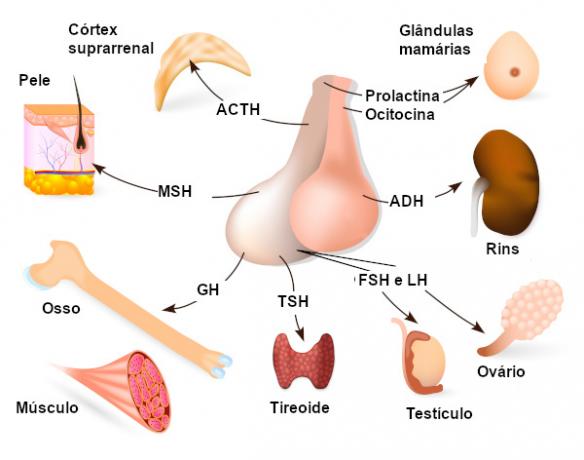THE pituitary or pituitary gland is a gland located in a cavity of the sphenoid bone. This gland attaches to the hypothalamus and is responsible for secreting some hormones produced in the latter region. It is worth noting that the pituitary gland also secretes its own hormones, which are responsible for controlling the activity of several other glands. Due to this control over other glands, the pituitary is constantly called the master gland.
These are hormones secreted by the pituitary:
- follicle-stimulating hormone,
- luteinizing hormone,
- thyroid stimulating hormone,
- adrenocorticotropic hormone,
- prolactin,
- growing hormone,
- oxytocin,
- antidiuretic hormone.
Read too: What are the p?major endocrine glands and which are hormones they produce?
What is the pituitary?
The pituitary is a gland located in a cavity of the sphenoid bone, at the base of the brain, which is about 1 centimeter in diameter and approximately 0.5 grams in an adult individual, a size similar to a bean seed. that gland has a direct connection with the
central nervous system through a pedicle. The gland is lined with a capsule of connective tissue.
Adeno-pituitary and neuro-pituitary
When we analyze the pituitary we find that it actually consists of two portions, which are joined together anatomically. This is due to the fact that the pituitary has a double embryonic origin, presenting nervous and ectodermal origin. The two portions of the pituitary are known as the adenohypophysis and the neuropituitary.
- Adenopituitary: portion originated from the ectoderm and can be subdivided into three regions: pars distalis, pars tuberalis and intermediate pars. THE pars distalis or anterior lobe is the most voluminous region, representing about 75% of the total pituitary mass. THE pars tuberalis, in turn, it embraces the infundibulum (part of the neurohypophysis). Finally, we have the pars intermedia which is located between the neurohypophysis and the pars distalis. THE nervous pair and the intermediate pars, together they form the posterior lobe of the pituitary.
- Neurohypophysis: as the name suggests, the neurohypophysis is the portion of the pituitary of nerve origin. We can identify a larger portion called nervous pair and a fixation pedicle called the infundibulum, which has a direct connection with the nervous system, more precisely with the hypothalamus.
Read too: endocrine systemo – system responsible for synthesizing hormones
Hormones produced by the pituitary
the pituitary is endocrine gland, that is, it is responsible for producing secretions, called hormones, which are released directly into the bloodstream. The portion that produces and secretes hormones is the anterior pituitary.
The neurohypophysis, in turn, is connected to the hypothalamus and is responsible for secreting hormones produced by this portion of the nervous system. Hypothalamic axons reach the neurohypophysis and secrete neurohormones produced in the hypothalamus. Let's learn about the hormones secreted by these two regions below:

Neuro-pituitary hormones
The neurohypophysis is responsible for secreting two hormones that are produced by the hypothalamus: the antidiuretic hormone and the oxytocin.
- Antidiuretic hormone (ADH): this hormone, also called vasopressin, has as its primary function the regulation of renal function, providing greater water absorption by the kidneys.
- Oxytocin: among other functions, it acts on the contractions of the uterus, at the time of childbirth, and on the ejection of milk.
Adenopituitary hormones
The adenohypophysis is responsible for synthesize and secrete your own hormones, which have a wide range of functions. Some of these hormones are responsible for controlling the activity of other glands, which ends up giving the pituitary gland the name of the master gland. See below the hormones it produces:
- Prolactin: responsible for stimulating the development of the mammary gland and milk production.
- Growth Hormone (GH): it acts on the organism's growth and metabolism.
- Melanocyte-stimulating hormone (MSH): stimulates melanin production.
- Thyroid stimulating hormone (TSH): stimulates the thyroid to synthesize and secrete its hormones.
- Adrenocorticotropic hormone (ACTH): stimulates the adrenal cortex to produce its hormones.
- Follicle Stimulating Hormone (FSH): in women, FSH promotes the development of ovarian follicles and estrogen secretion. In men, the hormone promotes spermatogenesis.
- Luteinizing hormone (LH): in women, it promotes ovulation and progesterone secretion. In men, in turn, it stimulates Leydig cells and the secretion of androgens.
By Vanessa Sardinha dos Santos
Biology teacher

